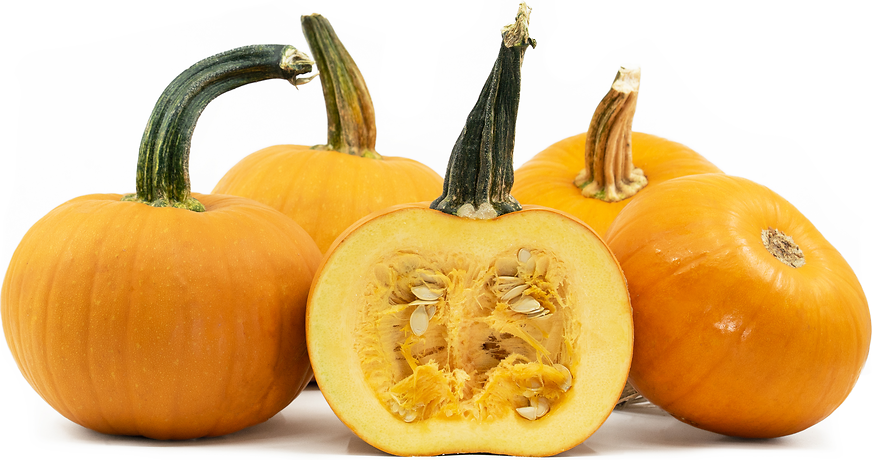


Organic Sugar Pie Pumpkins
This product is organically grown.
Specialty Produce is certified to handle organics.
Our California registration number is: 37-1293 Organically grown.
Estimated Inventory, 35 lbs : 0
Description/Taste
Sugar Pie pumpkins are small-sized pumpkins that average 15 to 18 centimeters in diameter and weigh about 2 to 3.5 kilograms each. They have a round, globular form that’s slightly flattened and notably uniform in shape. Their smooth orange rind has shallow and light vertical ridging that connects to a thick, ridged green-brown stem. Sugar Pie pumpkins have a dry, fine-grained flesh with a light orange color and firm, dense texture. This flesh surrounds a central cavity filled with pulp that’s less stringy and fibrous than most carving pumpkins, along with flat, cream-colored seeds. Sugar Pie pumpkins have a tender, buttery texture and a sweet, earthy, nutty flavor that caramelizes when cooked.
Seasons/Availability
Sugar Pie pumpkins are available from fall to early winter.
Current Facts
Sugar Pie pumpkins are botanically classified as Cucurbita pepo and are members of the Cucurbitaceae family along with squash and gourds. They are known by various names, including Boston Golden Sugar, Rhode Island Sugar, Boston Pie, Early Sugar, Golden Sugar, Prolific Sugar, and Yum Yum pumpkins. This variety is also referred to as New England pumpkins due to their native origins. They are a cultivar of Sugar pumpkins, a class of winter squashes known for their firm, smooth, and dense flesh that bodes well for baked goods. In addition to their culinary uses, Sugar Pie pumpkins are often grown as ornamental plants on sprawling vines that can reach 2.5 to 4.5 meters in length, making them popular for fall decor.
Nutritional Value
Sugar Pie pumpkins are a source of vitamins A, C, and E. These vitamins contribute to healthy vision and skin, immune function, cell growth, iron absorption, collagen production, reduced blood pressure, mood regulation, inflammation reduction, and protection from UV sun damage and cognitive decline. The pumpkins also provide calcium and potassium, both essential for maintaining strong bones, muscle function, and heart health. They are a good source of iron and zinc, which support red blood cell production, promote wound healing, regulate hormones, enhance mental health, preserve the senses of taste and smell, and help prevent oxidative stress. Phosphorus and copper are also present in this variety, helping maintain energy production, bone strength, and connective tissue health. Sugar Pie pumpkin seeds may have anti-parasitic, diuretic, and anti-inflammatory properties.
Applications
Sugar Pie pumpkins can be roasted, baked, sautéed, simmered, and occasionally eaten raw. They are most commonly used for baking and can be puréed for pies, cheesecakes, pancakes, tarts, breads, custards, and flan. In addition to sweet preparations, Sugar Pie pumpkins are often incorporated into savory dishes when tossed into soups and curries or hollowed out, stuffed, and baked similarly to acorn squash. This variety is often cubed or sliced into wedges and roasted as a side dish with flavorings like cinnamon, nutmeg, molasses, maple syrup, and brown sugar. Sugar Pie pumpkins are also used to make gnocchi, chili, empanadas, pasta sauces, and casseroles. Their seeds can be toasted, salted, and served as a snack. Sugar Pie pumpkins pair well with sage, rosemary, thyme, oregano, coriander, cloves, swiss chard, spinach, kale, peas, beans, hazelnuts, lobster, ham, potatoes, tomatoes, apples, and Gruyere cheese. They will keep for about 2 to 3 months when stored in a cool, dry place.
Ethnic/Cultural Info
Sugar Pie pumpkins are considered an heirloom variety and were likely used in some of the first pumpkin pie recipes in the United States. They are a descendant of the different pumpkin varieties introduced by the Native Americans, who valued pumpkins for their long storage life and versatile nature. These heirloom varieties not only provided seeds for the next year's crop but were also dried into strips for weaving mats. Pumpkins were presumably consumed at the first Thanksgiving between the Native Americans and the pilgrims, but pumpkin pie was an unlikely dessert to have been served as the flaky crusts common today would have required an oven. Instead, pumpkins were probably hollowed out, filled with spices, honey, and milk, and baked over an open fire, resulting in a sweet, toasted confection.
Geography/History
Sugar Pie pumpkins are native to New England and are believed to have been introduced by horticulturist Fearing Burr in the 1860s. This variety flourishes in climates with full sun exposure, well-drained soils, and daytime temperatures between 21 to 35 degrees Celcius when sown in the summer. They are a cultivated variety that’s bred for their sweet flavor, smooth flesh, and small size, commonly planted in home gardens and commercial farms for fall harvests. This variety has grown in popularity in the United States as a baking pumpkin commonly used in pumpkin pies and other holiday dishes. Sugar Pie pumpkins remain popular in New England, where they can be found growing throughout the fields during the fall. They are sold at farmers' markets and supermarkets throughout the United States in autumn and may occasionally be found in Mexico and Canada.
Recipe Ideas
Recipes that include Organic Sugar Pie Pumpkins. One
| The Foodie Physician |
|
Pumpkin Walnut Chili |
| Recipe Land |
|
Shrimp and Pumpkin Curry |

















